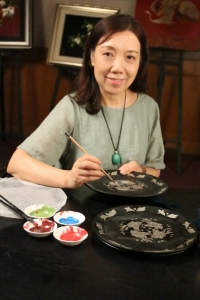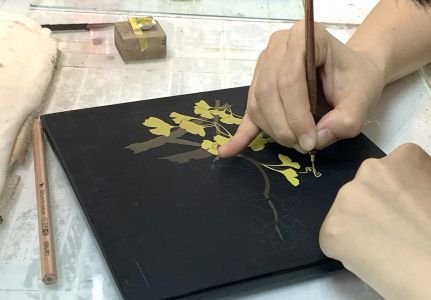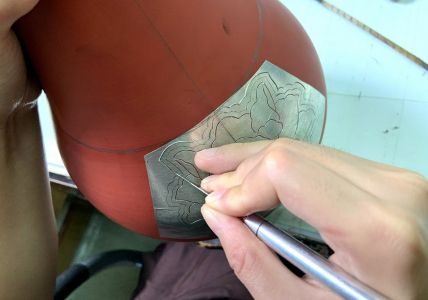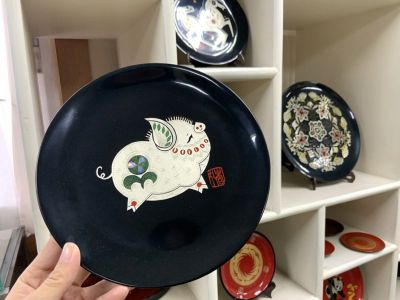Original title: integrate new elements to make lacquer return to life

Yin Liping

Painted gingko lacquer painting

Carve patterns on vases

Lacquerware dish
Under the spotlight, each piece of lacquer is gorgeous and elegant, some decorated with gold flakes and silver lines, and some inlaid with mother of pearl shells. Its beauty is breathtaking.
Chengdu Lacquer Craft Factory is located in a quiet alley. It still retains the style of the 1970s and 1980s, and the walls have long been weathered and become mottled. Yin Liping, a representative inheritor of Chengdu lacquer art, a national intangible cultural heritage, and a master of arts and crafts, has 44 years of experience in lacquer art in such a slightly inconspicuous factory. How will Yin Liping tell the story of her relationship with lacquer art, from her initial ignorance of lacquer art to her subsequent enthusiasm for it?
From Traditional Chinese Painting to Lacquer Art
44 years of work
"At the beginning, I didn't think I would follow the path of lacquer art." Yin Liping told the Tianfu Morning Post that she originally studied traditional Chinese painting, specializing in fine brushwork and landscape painting
In 1975, Yin Liping, 22, passed the examination and entered Chengdu Arts and Crafts Company. Under the fierce competition of thousands of applicants, she broke through the tight encirclement with her excellent painting skills and was assigned to the then Chengdu Lacquer Factory. "At that time, there were about 50 people with me," Yin Liping said.
Yin Liping's life of lacquer art has begun. "At the beginning of learning, I still felt that the process of lacquer art was too complicated. Although I had some painting skills, I learned many things from scratch." Yin Liping recalled her initial experience of learning lacquer art, sighing. After entering the Chengdu Lacquer Factory, Yin Liping studied under Chen Chunhe and Yu Shuyun for about five years, during which she learned all the production processes of lacquer ware such as bottom ash, painting, decoration and polishing, and also participated in some designs.
With constant learning, Yin Liping found that she gradually fell in love with the lacquer art. "Especially after seeing those inconspicuous materials and turning them into such beautiful works of art through her own hands, the sense of achievement is self-evident." It was at that time that Yin Liping really felt the infinite charm brought to her by the lacquer art, which is the source of her motivation for 44 years of work.
In 1980, Yin Liping entered Sichuan Academy of Fine Arts to study lacquer art design. When she returned to the factory after studying in 1981, she has been engaged in the design and production of lacquerware. Over the past 40 years, the lacquerware designed and produced by Yin Liping has won dozens of national awards, including the first prize of China Arts and Crafts Hundred Flowers Award in 1990 for the Rotating Lotus and Dragonfly Collection Box, which is now collected in the Treasure Museum of China Arts and Crafts Museum; "Fragrant Lacquer Art Series" won the gold medal of 2013 China Lacquer Art Exhibition. In 2011, Yin Liping conceived for 20 years and spent many years before and after making the "Peony Curl Grass Vase", which adopts the unique "carved lacquer silken halo" process of Chengdu lacquerware, becoming the largest handicraft in the history of Chengdu Lacquerware Factory with a clear height of 2.3 meters and a diameter of 90 centimeters.
"Later, I also continued to study and study lacquer art, and also went to the Central Academy of Arts and Crafts to continue my studies." Yin Liping said that while her skills were maturing, her feelings for lacquer art became less and less profound.
Lacquer art development is at a low ebb
But never thought of giving up
Chengdu lacquer art has a history of more than 3500 years. It was first unearthed in the Yin Shang era, but Yin Liping believed that the Yin Shang era was only the "growth period" of the development of Chengdu lacquer art, rather than the "enlightenment period". "Because the lacquer wares unearthed at that time had begun to have fine black and red patterns, and at the same time there was the turquoise inlaying process." She said, The glorious period of Chengdu's lacquer art appeared in the Han Dynasty. "In the Han Dynasty, lacquer ware was a symbol of identity and status." However, since the Han Dynasty, with the emergence of vessels of different materials, lacquer ware gradually declined.
In the 1950s, relevant departments gathered Chengdu lacquer craftsmen and established the Chengdu Lacquer Cooperative in 1954. In 1956, it was officially renamed Chengdu Bittern Paint Factory, which was initially used as a gift for export and foreign exchange exchange. In the early 1960s, Chengdu lacquerware experienced its first low ebb; In the 1970s, due to the country's efforts to develop arts and crafts, Chengdu lacquerware ushered in a glorious period again and was officially renamed as Chengdu Lacquerware Craft Factory.
But the good times didn't last long. Chengdu Lacquerware Factory encountered a situation of production suspension from 1995 to 2000. Yin Liping recalled: "In those five years, I temporarily worked in a design company, always thinking about Chengdu Lacquerware Factory and Chengdu Lacquerware Art, and insisted on continuing to make lacquerware at home." After the Chengdu Lacquerware Factory resumed production, the boss of the design company allowed me to stay, Yin Liping insists on returning to work in the lacquer factory. At this time, many old workers in the lacquerware factory left one after another, and their wages and quality were very low. Even so, Yin Liping continued to stay here with her love and obsession for lacquer art, and never gave up.
More and more young people are willing to learn
I feel relieved
Yin Liping said frankly that from 1992 to 2006, Chengdu Lacquer Factory belonged to the talent generation period, and there was no successor. She said: "Lacquer art is a craft. It takes at least three or five years to learn it. The same effort may have been popular in other industries, but it is hard to say in the lacquer industry."
In 2006, the opportunity of Chengdu lacquer art appeared, and it was included in the first batch of national intangible cultural heritage lists. In June 2007, Yin Liping was selected as the representative inheritor of the first batch of national intangible cultural heritage projects. "Since then, Chengdu lacquer art has received more and more attention, and now its popularity has been greatly improved," Yin Liping said. At present, Chengdu Lacquerware Factory has a total of 41 employees, most of whom are young people, mainly after 80s and 90s, and a few after 00s.
When the reporter walked into the workshop, he was deeply affected by the dedicated patience of these young people. Whether it was painting, polishing or later carving, even though the working environment was slightly difficult, each of them still focused on his own work without any slack. Even if the process needed to be repeated hundreds or thousands of times, they never complained. "Lacquerware production process is complex. The simplest works need to be produced for about 45 days, and they can be produced for months to years." Yin Liping sighed, "but I am really pleased to see that more and more young people are willing to learn and can still persist."
With the progress of the times, the development of Chengdu lacquer art has also met some challenges. "I think lacquer art now needs to incorporate some new elements to make it shine new charm," Yin Liping said. So she integrates modern fashion elements into lacquer ware, and also combines lacquer ware with metal, glass products, environmental decoration and other materials across borders.
Yin Liping put forward the design and production concept of "let the lacquer art return to life and bring it home", so that lacquer ware can enter more people's homes. So she and the team designed and made tableware, tea sets, wine sets, stationery, etc., which were truly integrated into life, and the design was simple and generous, minus too much decoration, which also reflected the diversity and practicality of lacquer ware.
As long as the school invites
I will definitely find time to give lectures
"My current idea is to teach more students, do more communication and research, and try my best to design and produce more works," Yin Liping said. At present, Yin Liping has been a visiting professor of design in some universities, focusing on promoting Chengdu lacquer art, including Sichuan Media College, Chengdu University, Chengdu Polytechnic Institute, etc. It is worth mentioning that Yin Liping was also invited by Sichuan Academy of Fine Arts to teach students. "Sichuan Academy of Fine Arts can also be regarded as my alma mater. I have gained a lot of lacquer art skills and experience there, and I am still very grateful for it. So no matter how busy I am, I will definitely find time to go as long as the school invites me," Yin Liping told reporters.
Yin Liping painstakingly described her 44 years of lacquer art life; Undaunted by the dangers ahead, she only wanted to derive her most sincere love from her heart. "I may stick to it until I can't do it," Yin Liping said with a smile. (Tianfu Morning Post reporter Zhao Xia intern Zhang Enming)
(Editor in charge: Jiang Bo, Ding Tao)
Share to let more people see


































